|
|
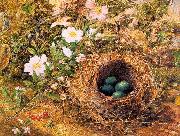 |
Hill, John William
|
|
English Painter, 1812-1879
Painter and illustrator, son of John Hill. At the age of seven he moved to Philadelphia, PA, with his family. In 1822 he moved to New York, where he was apprenticed to his father for seven years. During this time, he worked on the aquatint plates for William Guy Wall's Hudson River Portfolio (1821-5), |
|
|
|
|
|
|
|
|
|
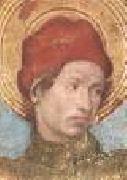 |
HUGUET, Jaume
|
|
Spanish Early Renaissance Painter, ca.1415-1492
Spanish painter. He is thought to have spent time in Saragossa in his youth (c. 1435-45), and he subsequently worked in Tarragona before establishing himself in Barcelona in 1448. He must, however, have had contact with painting from Barcelona before he moved there, because the centre panel of an early retable dedicated to the Virgin (Barcelona, Mus. A. Catalunya) from Vallmoll, near Tarragona, shows his awareness of the style of Bernat Martorell in the profiles of the two foreground angels, and of Llu?s Dalmau's Virgin of the Councillors (Barcelona, Mus. A. Catalunya) in the illusionistic painting of the Virgin's jewel-trimmed garments. In other early works, such as the Annunciation and Crucifixion from a small retable (Vic, Mus. Episc.), |
|
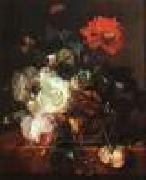 |
HUYSUM, Jan van
|
|
Dutch Painter, 1682-1749
Dutch painter of still life and landscapes. His father was Justus van Huysum (1659?C1716), a successful landscape and genre painter of Amsterdam. Although he painted landscapes in a classical style, Jan is best known for his flower and fruit still lifes in oil and in watercolor. These are distinguished for their brilliant light and shade effects, delicacy of coloring, and exquisite finish. They are to be found in most of the leading European museums |
|
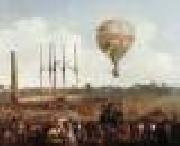 |
IBBETSON, Julius Caesar
|
|
English Painter, 1759-1817
English painter, printmaker and writer. The son of a clothier, he was apprenticed to John Fletcher, a ship painter in Hull; in 1775 Ibbetson became a scene-painter there. In 1777 he moved to London, where he worked as a scene-painter and picture restorer. He married about three years later. From 1785 he exhibited landscapes, genre scenes and portraits at the Royal Academy. In 1787-8 Ibbetson was personal draughtsman to Col. Charles Cathcart on the first British Mission to Beijing, a voyage that included visits to Madeira, the Cape of Good Hope and Java. His watercolour False Bay, Cape of Good Hope (London, V&A), made on this journey, shows a picturesque roughness of foliage and rustic staffage adapted from his English landscape style. Cathcart's death forced Ibbetson to return to England (he exhibited an oil painting, untraced, of the Burial of Col. Cathcart in Java at the Royal Academy in 1789); thereafter he lived by painting landscape oils and watercolours, the subjects culled from his frequent tours. He painted occasional portraits throughout his career (e.g. Young Man, 1790; Leeds, Temple Newsam House) and contributed to John Boydell's Shakespeare Gallery (e.g. Scene from 'The Taming of the Shrew', untraced, see Waterhouse, p. 192). In 1789 he stayed with John Stuart, 3rd Earl of Bute, at Cardiff Castle and visited the Isle of Wight in 1790. In 1792 he toured Wales and the surrounding area with the painter John 'Warwick' Smith and his companion Robert Fulke Greville, resulting in the publication of his book of engravings, A Picturesque Guide (1793). His oil painting of Aberglasyn: The Flash of Lightning (Leeds, C.A.G.) evokes the sublimity of the mountainous Welsh terrain; the drama of the storm over Aberglasyn is conveyed by thick impasto and strong chiaroscuro, a way of handling paint that Ibbetson learnt from copying 17th-century Dutch masters while working for a London dealer named Clarke during the late 1770s and early 1780s. |
|
|
|
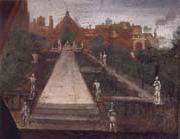 |
Inigo Jones
|
|
English Baroque Era Architect, 1573-1652,Masque designer, architect, and courtier, Jones's architectural legacy only fructified in the early 18th cent. through the neo-Palladian movement. Yet Jones personally remains frustratingly elusive, for all his arrogance and engrossing power as surveyor of the king's works (1615-44). Apart from entrancing scenic and costume designs, only seven of Jones's 45 architectural works survive: the most notable are the Whitehall Banqueting House, Queen's chapel at St James's, Queen's House at Greenwich, and, by no means least because of its Carolean town-planning context, St Paul's church, Covent Garden. |
|
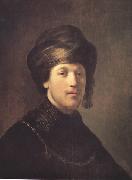 |
Isack jouderville
|
|
c,1612-before 1648
Dutch painter. His father, who came from Metz, kept a popular inn at Leiden. Isack Jouderville was among Rembrandt's earliest pupils and was apprenticed to the artist from late 1629 until the end of 1631. for the payment of his apprenticeship fees, signed by Rembrandt. During his last year of apprenticeship, Jouderville went to Amsterdam with Rembrandt. In 1632 he enrolled as a student of philosophy at Leiden University; it may well be, however, that he stayed in Amsterdam to assist Rembrandt in his workshop with his numerous portrait commissions. Jouderville himself painted mainly Rembrandtesque heads or 'tronies' and was such a faithful follower of his master's early work that several of his paintings were at one time attributed to Rembrandt. In 1636 Jouderville married Maria Le Fevre and settled in Leiden. Between 1641 and 1643 he lived in Deventer, after which he moved to Amsterdam, where he was last recorded in 1645. |
|
|
|
 |
J B Armand Guillaumin
|
|
1841-1927
Born Jean-Baptiste Armand Guillaumin in Paris, France, he worked at his uncle's lingerie shop while attending evening drawing lessons. He also worked for a French government railway before studying at the Academie Suisse in 1861. There, he met Paul C??zanne and Camille Pissarro with whom maintained lifelong friendships. While he never achieved the stature of these two, his influence on their work was significant. C??zanne attempted his first etching based on Guillaumin paintings of barges on the River Seine.
Guillaumin exhibited at the Salon des Refus??s in 1863 and later became a friend of Vincent van Gogh whose brother, Theo sold some of his works.
Noted for his intense colors, major museums around the world display Guillaumin's art. He is best remembered for his landscapes of Paris, the Creuse departement, and the area around Les Adrets-de-l'Esterel near the Mediterraneran coast in the Provence-Alpes-Cote d'Azur region of France.
Armand Guillaumin died in 1927 in Orly, Val-de-Marne just south of Paris. |
|
|
|
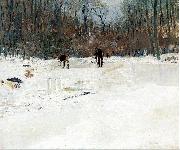 |
J. Alden Weir
|
|
(August 30, 1852 - December 8, 1919) was an American impressionist painter and member of the Cos Cob Art Colony near Greenwich, Connecticut. Weir was also one of the founding members of "The Ten", a loosely-allied group of American artists dissatisfied with professional art organizations, who banded together in 1898 to exhibit their works as a stylistically unified group.
|
|
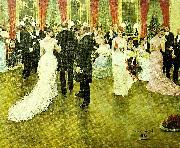 |
j. beraud
|
|
1849-1935
1849 - Saint Petersburg, Russia - 1935 Paris)
Scenes of daily life painted by Jean Beraud reveal interest in Naturalism. Such diverse themes as crowds observing the funeral of Victor Hugo (see Carnavalet, Paris) or studies of the interior of a Parisian Bank Apartment reflect aspects of French society during the Third Republic. |
|
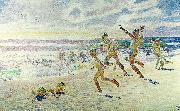 |
j. f. willumsen
|
|
(7. september 1863 i København - 4. april 1958 i Cannes) var en af pionererne bag det moderne gennembrud i dansk billedkunst omkring 1900. Han var primært maler, men mestrede de fleste kunstarter og arbejdede desuden som billedhugger, grafiker, keramiker, arkitekt og fotograf.
J.F. Willumsen studerede ved Det Kongelige Danske Kunstakademi fra 1881 til 1885. Efter tre forgæves forsøg på at blive indstillet til afgangsprøven på Kunstakademiet, studerede han på Kunstnernes Frie Studieskoler i København. I 1891 var han med til at stifte Den Frie Udstilling, hvis udstillingsbygning han tegnede i 1898.
Willumsen opholdt sig i hovedparten af sit liv uden for Danmarks grænser, hovedsageligt i Frankrig, hvor han under et ophold i Paris 1890-94 blev præget af symbolismen. I de følgende årtier blev han eksponent for flere af epokens kunstretninger og hans stil ændredes i mere ekspressiv retning.
Willumsen tilbød en stor del af sine værker og kunstsamling til staten og arbejdede fra 1930'erne på oprettelse af et museum. I 1957, året før hans død, åbnede J.F. Willumsens museum i Frederikssund. |
|
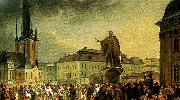 |
j. g. sandberg
|
|
Johan Gustaf Sandberg, född 1782, död 1854, var målare; han var professor i teckning vid Konstakademien från 1828, och direktör där 1845?C1853.
Sandberg ägnade sig främst åt historiemåleri, med motiv ur nordisk mytologi och svensk historia. Hans främsta verk inom detta område är kalkmålningarna över Gustav Vasa i Uppsala domkyrka. Han målade också en mängd porträtt.
Efter akademiska studier i Åbo med början 1783, och Uppsala, dit han flyttade 1788, blev han filosofie magister 1791. Han blev 1792 extra ordinarie kanslist i akademiska kansliet. Juris utriusque kandidat blev han 1792 och kort därefter docent vid juridiska fakulteten, blev juris licentiat 1800 och utnämndes 1807 till jurisprudentiä, oeconomiæ et commerciorum professor i Uppsala. Juris utriusque doktor 1810; arbetande ledamot i Lagkommissionen 1811-1814; ledamot av Krigsvetenskapsakademien 1810, Lantbruksakademien 1812, Vetenskapssocieteten i Uppsala 1829 samt flera andra lärda samfund. År 1834 erhöll han adlig värdighet och tog avsked från sin professur 1837. Lars Rabenius ligger begravd på Uppsala gamla kyrkogård. |
|
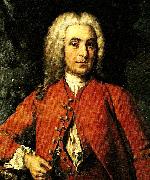 |
j. h. scheffel
|
|
Wismar 1690 - Västerås 1786
J.H. Scheffel kom från en borgasläkt i Wismar, en nordtysk stad som på 1600-talets införlivats med Sverige. Om Scheffels läroår vet man ingenting utöver uppgiften i en gammal biografi att han studerade till målare i Berlin, Paris och Brabant.
Scheffel dök upp i Stockholm år 1723. Uppenbarligen samarbetade han först med David von Krafft. Efter dennes död 1724 grundade Scheffel, då redan fullärd porträttör, sin egen atelj??. Ett av de första uppdragen, porträttet av borgmästare Bergstedts unga dotter, ledde till ett lyckligt och av en riklig hemgift åtföljt äktenskap med fröken Bergstedt.
Scheffel samlade redan tidigt kring sig en trogen kundkrets bland adeln och det förmögna borgarskapet. Han behöll sin framgångsrika position från 1720-talet till 1760-talet. Någon ledande hovmålare eller mest gynnad societetsmålare i Stockholm var Scheffel aldrig. Hans stadiga popularitet som pålitlig och kompetent porträttmålare rubbades emellertid inte av modets växlingar, ty han hade förmågan att smidigt följa de nya strömningarna utan att pruta på sin karga och förnuftiga konstnärliga egenart. Scheffels porträtt visar sällan prov på pretentiösa barockgester eller affekterad romantisk tillgjordhet. Hans personåtergivning var utfunderad och konstaterande. I hans digra produktion ingår stela rutinarbeten, men i bästa fall är hans målningar karaktärsstudier som bygger på en stark vision. Hans målningsteknik var kompetent men anspråkslös: i helheten fäster man uppmärksamhet vid mänskobilden, inte vid utförandet.
När Scheffel i 75-årsåldern som pensionerad drog sig tillbaka för att tillbringa tiden med sin familj var han en rask och förmögen gammal herre. Han uppnådde den för tiden ovanligt höga åldern av 91 år, enligt dottersonen till följd av sitt glada och jämna humör, sina ordentliga levnadsvanor och en till åldern anpassad flit och motion .
|
|
|
|
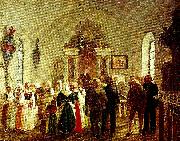 |
j. w. wallander
|
|
Jan Wallander är en svensk forskare, författare och företagsledare född 1920. Han är son till arkitekten Sven Wallander. Efter sin doktorsexamen var han verksam som nationalekonom vid Studieförbundet Näringsliv och Samhälle som han var chef för i början av 1950-talet, 1953-1961 var han chef för Industrins Utredningsinstitut. Han bytte bana från forskningen till banksektorn när han anställdes som direktör för Sundsvallsbanken 1961. |
|
|
|
|
|
|
|
|
|
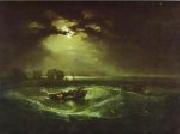 |
J.M.W. Turner
|
|
English Romantic Painter, 1775-1851 landscape master
landscape master .British painter and printmaker. He dominated British landscape painting throughout the first half of the 19th century. He established a reputation in the Royal Academy, London, first as a topographical watercolourist and then within a few years as a painter of Sublime and historical landscapes. |
|
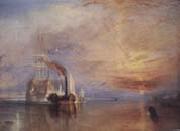 |
J.M.W.Turner
|
|
English Romantic Painter, 1775-1851, British land- and seascape artist. Born in London the son of a barber, Turner was precociously talented. He entered the RA Schools in 1789, had a drawing exhibited at the academy in 1790, and was elected a full academician in 1802. He became professor of perspective in 1807. A prolific artist of amazing range of subject and style, he began work in water-colours, quickly founding both a reputation and a fortune, which made him independent of changing public taste. His work was not appreciated by everyone, but his supporters included Thomas Lawrence, John Ruskin, and the earl of Egremont. He died in eccentric obscurity under a false name. |
|
|
|
|
|
|
|
|
|
|
|
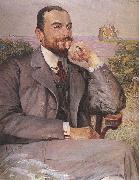 |
Jacek Malczewski
|
|
(15 July 1854 in Radom - 8 October 1929 in Krakow) was one of the most famous painters of Polish Symbolism. In his creativity he successfully joins the predominant style of his times with motifs of Polish martyrdom.
|
|
|
|
|
|
|
|
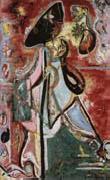 |
Jackson Pollock
|
|
l912--1956,U.S. painter. He grew up in California and Arizona. In the early 1930s he studied in New York City under Thomas Hart Benton, and later he was employed on the WPA Federal Art Project. In 1945 he married the artist Lee Krasner. Two years later, after several years of semiabstract work stimulated by psychotherapy, Pollock began to lay his canvas on the floor and pour or drip paint onto it in stages. This process permitted him to record the force and scope of his gestures in trajectories of enamel or aluminum paint that veiled the figurative elements found in his earlier work. The results were huge areas covered with complex and dynamic linear patterns that fuse image and form and engulf the vision of the spectator in their scale and intricacy. Pollock believed that art derived from the unconscious and judged his work and that of others on its inherent authenticity of personal expression. He became known as a leading practitioner of Abstract Expressionism, particularly the form known as action painting. Championed by critic Clement Greenberg and others, he became a celebrity. When he died in a car crash at 44, he was one of the few American painters to be recognized during his lifetime and afterward as the peer of 20th-century European masters of modern art. |
|
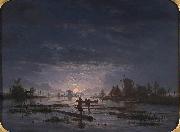 |
Jacob Abels
|
|
(1803 - 1866) was a Dutch painter.
He was born in Amsterdam in 1803, and was instructed in art by Jan van Ravenswaay, the animal painter. In 1826 he visited Germany, and on his return settled at the Hague. He distinguished himself especially in painting moonlight landscapes. The Museum at Haarlem has works by him. Abels died at Abcoude in 1866.
|
|
|
|
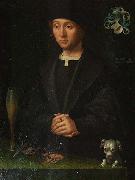 |
Jacob Claesz van Utrecht
|
|
also named by his signature Jacobus Traiectensis (born c. 1479 - dead after 1525) was a Flemish early Renaissance painter who worked in Antwerp and Lebeck.
Jacob van Utrecht's life is still very much in the dark. Research on this important Flemish artist did not start before the end of 19th century. He was probably born in Utrecht, although it is not certain. It is assumed that he became a citizen of Antwerp around 1500 and he is recorded as a "free master craftsman" of the Guild of St Luke there from 1506 to 1512.
From 1519 to 1525 he is recorded as a member of the Leonardsbruderschaft ("Leonard's Brotherhood"), a religious confraternity of merchants in Lebeck among whose ranks the leaders of the Protestant Reformation in the 1530s could be found.
From then on no traces of his life have been found.
|
|
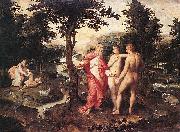 |
Jacob de Backer
|
|
(c. 1555 - c. 1585) was a Flemish Mannerist painter and draughtsman active in Antwerp between about 1571 and 1585.
According to the RKD he was born in Antwerp in c.1540/45 and died there c.1591-1600.De Backer was abandoned by his father as a young boy. Carel van Mander reports that the artist studied with Antonio van Palermo and Hendrik van Steenwijk I, but that Palermo worked him so hard that the young de Backer died in the arms of his master's daughter at the age of thirty.
Although the artist painted in the high mannerist style of Giorgio Vasari, he never appeared to travel to Italy. A series of the "Seven Deadly Sins", however, was bought in Antwerp by Alessandro Farnese's secretary Cosimo Masi in 1594 and taken to Italy.These paintings are now in the Museo di Capodimonte in Naples. Other attributable works include a Last Judgment triptych by him or his studio for Christophe Plantin's tomb in the Antwerp Cathedral (c. 1589; illustrated right), and an Allegory of the Three Ages of Man in the Hermitage Museum, St. Petersburg.
He is not to be confused with the Dutch Golden Age painter Jacob Adriaensz Backer from
|
|
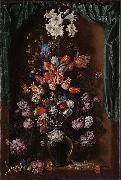 |
Jacob de Gheyn II
|
|
Jacob de Gheyn II (also Jacques de Gheyn II) (c. 1565, Antwerp - March 29, 1629, The Hague) was a Dutch painter and engraver, whose work shows the transition from Northern Mannerism to Dutch realism over the course of his career.
|
|
 |
Jacob de Wit
|
|
(19 December 1695 - 12 November 1754) was a Dutch artist and interior decorator who painted many religious scenes.
De Wit was born in Amsterdam, and became famous for his door and ceiling paintings. He lived on the Keizersgracht in Amsterdam, and many of the buildings on the Keizersgracht still have door or ceiling paintings done by him. Since many of the families who lived in Amsterdam in those days had country villas, de Wit also painted in houses in the fashionable areas of Haarlem and the Vecht river.
According to the RKD he was the pupil of Albert Spiers in Amsterdam and Jacob van Hal in Antwerp where he became a member of the Guild of St. Luke in 1714. His pupils were Jan de Groot (painter from The Hague), Dionys van Nijmegen, Jan Punt, Pieter Tanje, and the brothers Frans and Jacob Xavery. De Wit died in Amsterdam in 1754.Tako Hajo Jelgersma was his follower. |
|
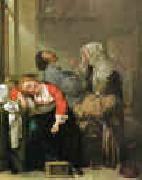 |
Jacob Duck
|
|
1600-1667
Dutch
Jacob Duck Location
Dutch painter and etcher. He was long confused with Jan le Ducq (1629/30-76). In 1621 he was listed as an apprentice portrait painter in the records of the Utrecht Guild of St Luke. His teacher was probably Joost Cornelisz. Droochsloot (1586-1666). The St Job Hospital in Utrecht acquired a Musical Company by him in 1629. By 1630-32 he was a master in the guild. Like Pieter Codde, he painted guardroom scenes (kortegaerdjes), for example Soldiers Arming Themselves (c. 1635; New York, H. Shickman Gal., see 1984 exh. cat., no. 36) or the Hoard of Booty (Paris, Louvre), in which the figures and their interactions are apparently full of underlying symbolic meaning. He also painted merry companies (e.g. c. 1630; Names, Mus. B.-A.) and domestic activities, such as Woman Ironing (Utrecht, Cent. Mus.), employing motifs perhaps symbolic of domestic virtue. He placed his figures in high, bare interiors in which the deep local colours of the foreground stand out well against the cool, greyish-brown background. Only a few of his etchings are known (Hollstein, Dut. & Flem., vi, pp. 9-11), depicting figures in contemporary dress, for example Young Gentleman with Broad Hat and Cloak (Hollstein, no. 10) or Virgin and Child with Magi (nos 1-4). Between 1631 and 1649 Duck presence is documented in Utrecht, Haarlem and Wijk bij Duurstede. Afterwards, and probably by 1656, he was living in The Hague. He was buried at the monastery of St Mary Magdalene in Utrecht. |
|
 |
Jacob Ferdinand Voet
|
|
(c. 1639 - c. 1689/1700) was a Flemish Baroque portrait painter.
According to the Netherlands Institute for Art History (RKD) he was born at Antwerp as the son of the painter Elias Voet.[1] He travelled to Rome in 1679-1680, Milan in 1680, Florence in 1681, Turin in 1682-1684, and returned to Antwerp in 1684. While in Rome he lived with the painter-engraver Cornelis Bloemaert until he was banned for his portraits of women portrayed with unseemly decollet, whereupon they left Rome together. He undertook a journey to Paris in 1686 where he became court painter until he died there.He is registered as a painter of miniature portraits.
According to Houbraken, he made his return journey to Antwerp from Turin in the company of Jan van Bunnik, who he had already met in Rome in the company of Cornelis Bloemaert. From Turin they set out for Lyons, where they met Adriaen van der Cabel, Peter van Bloemen, and Gillis Wenix. They set off for Paris in the company of a third painter who was a good painter of "bataljes" or battle scenes. Houbraken reports that this was Jacob, Jan van Bunnik's brother, but had not mentioned him earlier in his Jan van Bunnik biography. The RKD makes no mention of a Jacob van Bunnik. |
|
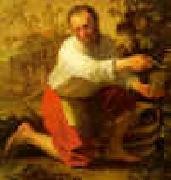 |
Jacob Gerritsz Cuyp
|
|
1594-1652
Dutch
Jacob Gerritsz Cuyp Locations
Painter and draughtsman. Probably taught by his father, he entered the Guild of St Luke in Dordrecht in 1617, the same year that he executed an important commission to portray the masters of the Holland Mint (Dordrecht, Mus. van Gijn). He was the Guild bookkeeper in 1629, 1633, 1637 and 1641 and, according to Houbraken, led Dordrecht fine painters in their separation from the Guild in 1642. Jacob married Aertken van Cooten from Utrecht in 1618; his only child, (3) Aelbert Cuyp, was born two years later. |
|
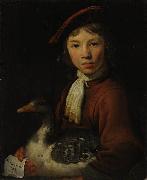 |
Jacob Gerritsz. Cuyp
|
|
was a portrait and landscape painter. He was born and died in Dordrecht, and was the half-brother of Benjamin Gerritsz Cuyp and the father of the much more famous Aelbert Cuyp.
According to Houbraken, he helped the painters Jacques de Claeuw, Isaac van Hasselt, and Cornelis Tegelberg set up a Guild of Saint Luke in Dordrecht in 1642.
|
|
|
|
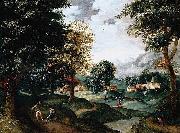 |
Jacob Grimmer
|
|
(ca. 1526-1590) was a Flemish Renaissance landscape painter.
Grimmer was born and died in Antwerp. According to Karel van Mander he first learned to paint landscapes from Matthys Cock and later from Christiaen Queburgh, both of Antwerp. He was a very skilled painter of houses, sky, and foreground views. He was a member of the Guild of St. Luke who was active as a rederijker and acted in many plays.
According to the RKD his earliest dated work is from 1546 and his latest dated work was 1589. Most of his works are landscapes and he worked together with Gillis Mostaert. Abel Grimmer was his son and pupil.
|
|
 |
Jacob Heinrich Elbfas
|
|
Swedish, born circa 1600-1664,was a portrait painter Elbfas was educated in Strasbourg in a tradition drawing back to Renaissance portraits. He established himself in Sweden from 1622 and from 1628 in Stockholm where he became a guild master. During the period 1634-1640 he worked as a court painter for Queen Maria Eleonora. His was frequently employed by the Swedish nobility and his influence on Swedish art was considerable until a new generation of artists were invited by Queen Christina during the 1640s. |
|
|

